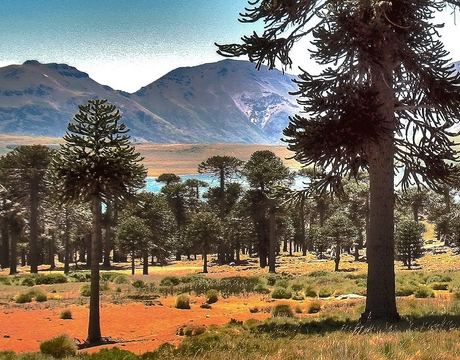
Continuing on with the theme of the last several posts which examined reconstructions of fossil forests here are the results of another research paper released this past week (reference below). In this study the authors examined records of more than 2200 fossilized wood collections just from Cretaceous aged rocks at locations all around the world. They identified the type of wood was fossilized which was several types of conifers including pines and one type of angiosperm (flowering plants) which are grouped as Magnolias. They also measured the average diameters of tree rings which in many cases are preserved in the fossil record (see picture for example).
What did they find? The figure below is a summary of those results. In the early Cretaceous (oldest rock, deepest rock of that time period) the types of wood found on all of the continents of the time were exclusively conifer types especially of a type of conifer that is only found in the southern hemisphere today (the Araucaroiods – see picture). Time periods T1 through T4 on the figure below represent rock layers that are above each other and represent younger and younger rock (see legend for dates).

Notice NO angiosperm wood at time T1. That means no evidence of maples, no oaks, no hickories, no magnolias, no ashes, etc… No evidence of any type of flowering plant wood. On the other hand rocks from all over the world at that same layer of rock have preserved conifers in them which are so well-preserved that the tree rings can be counted. Notice that in time period T2 there are a few angiosperms (all of these are one kind – Magnolia family type of wood). By time period T4 which is the end of the Cretaceous, at which point the dinosaurs disappear, angiosperms (flowering plant trees) are the dominant tree type in fossil record.

What are the implication of this data? Just like my previous posts on reconstructed Permian forests and the Carboniferous forest of New York the lack of any evidence of flowering plants in many layers of rock is striking and suggests a time when no flowering plants were present in the biota. Is there other evidence to support the inference that angiosperms simply were not present at the time the lower layers of rock were deposited? Yes, there is one interesting line of independent evidence which fits this data very well. Dinosaurs were around during this entire time frame and thus would have experienced these changed in forest types. Fossilized dinosaur coprolites (dino poop!), for which there are more found than dinosaurs themselves, can be examined to deduce what the dinosaurs that “dropped” these remains were eating. As you might predict, fossilized dino dung from rocks of time interval T1 are full of ferns and conifers to the exclusion of flowering plants. They do not appear to have eaten any flowering plants. The natural inference from this is that there were no flowering plants to eat otherwise surely they would have eaten them since few organisms would choose a conifer over a juicy magnolia leaf. Dinosaur dung from time interval T4 has plentiful angiosperm plants in it including preserved flowering plant pollen grains.
So the dino poop data correlates to the fossil tree data. This type of correlation is the type that young earth creationists rarely acknowledge in their publications. Why should fossil poop and tree trunks be correlated with one another on a global scale if both were simply tossed around in a global flood. The presence of millions of fossil dino poops found in discrete layers of rocks is another fascinating subject but will be left for another time.
Reference:
E. Peralta-Medina and H. J. Falcon-Lang. 2012. Cretaceous forest composition and productivity inferred from a global fossil wood database. Geology March 1 Issue. (A pre-publication version can be access here)